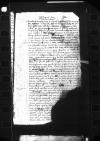Non sine singulari consolatione Serenissimae Reginalis Maiestatis Vestrae benignissimas legi ⌊⌋, quibus se affectae meae valetudinis clementem commiserationem habere indicat. Pro qua propensa in me gratia Serenissimae Maiestati Vestrae, quantum possum, demissius atque diligentius gratias habeo immortales, Dominum Deum intime orans, ut eandem Serenissimam Maiestatem quam diutissime ab omni aegrotatione doloreque incolumem conservet.
Ceterum, quod Serenissima Maiestas Vestra me clementer commonet, ut, si interim convaluero, felicibus nuptiis[1] serenissimae ⌊maiestatis regiae iunioris⌋, domini mei clementissimi, cum id tempus postulabit, inservire non detrectem, in quo quidem, si Deus salubrius corpus et ea, quae ad tam splendidas nuptias honestandas ex misericordia sua concesserit, dummodo temporius de mente serenissimae ⌊maiestatis regiae⌋ edoctus fuero, quoad eius per valetudinem a me fieri poterit, obsequentem me praestabo.
Atque utinam hoc clarissimum coniugium Deus fortunet, prosperet faustissimumque faciat, ne malorum hominum, qui de eo perperam praepostereque ominantur, malevolentia, quam contra hoc Dei institutum et voluntatem conceperunt, quae maxime in matrimoniis suam ostendit potentiam, succedat. Huc ad nos in eo varia perferuntur, meque interdum afficiunt, suppliciter itaque rogo, si quid est, quod me scire liceat, Serenissima Maiestas Vestra pro iurata mea fide me latere non velit.
Quod vero ⌊oratores Germani⌋, qui ad serenissimam ⌊maiestatem regiam⌋ mittuntur, adeo diligenter de me inquirunt, non nisi veteris societatis fortassis fit ratione, neque qui me penitius norunt, suspicari possunt, quod ob id in aula non sim, ut qui in ea Serenissimarum ⌊Maiestatum Vestrarum⌋ gratiam non habeam, cum me sciant illis tam longo tempore fideliter inservivisse.
Non possum celare Serenissimam Maiestatem Vestram, quod superiori tempore, cum ex ⌊Vratislavia⌋ rediissem, ⌊dominus de Granvela⌋ procancellarius et intimus ⌊caesareae maiestatis⌋
consiliarius, praeterea et quidam alii de veteribus amicis, ad me nomine ⌊caesareae maiestatis⌋ scripserunt, ut ex me [expis]carentur, si mihi mens esset rubri suscipiendi galeri. ... mihi seriam operam esse pollicitam . Quibus re... [⌊maiestati⌋ caesa]reae summas gratias habui meque eam tam in me ... et longe minus istiusmodi excelsum fastigium pro... eius ⌊maiestas caesarea⌋ pro sua in me ... [cle]mentia gratissimam gratiam facere vel[let] ... [apud] ⌊Poloniae regem⌋ efficeret, ut me eius ...geret, ne umquam extra episcopatus m[ei fines] ... tantum abesse, quod ego id amb[iam] ... dignitate maiores sumptus ... ob id scribo, cum iam omni ..., dum parum me attingit ... ⌊Maiestatum Vestrarum⌋ gratiam habeam ....
Nova, quae ad praesens apud nos narrantur, licet non admodum sint certa, ut tamen iussis Serenissimae Maiestatis Vestrae satisfiat, sic habent: Rumor huc perl[a]tus est ⌊Scotos⌋ superiores fuisse ⌊Anglis⌋ magna caede edita. Quando ver[o] et quibus modis facta sit et quomodo cuncta successerint, nondum compertum habetur.
Ex ⌊Suecia⌋ fertur quod ⌊incolae illi⌋ strennue suum persequuntur ⌊tyrannum⌋, quem confoederati deseruisse omnes dicuntur, quorum unus ⌊Danorum rex⌋, cum illi nuper quadringentos equites et pedites octingentos per speciem, ut aiunt, mittere statuisset, causabatur milites eo proficisci reluctatos esse . Quidam autumant, quod ⌊fratrem⌋ suum ⌊hinc⌋ a ⌊sororio⌋ suo evocatum ⌊Suecis⌋ praeficere conetur. ⌊Lubecenses⌋ item et ⌊Hamburgenses⌋ ⌊ducem Magnipolensem vulgo Mekelburgensem Albertum⌋, qui etiam superioribus annis ad ⌊Daniae regnum⌋ aspiraverat, ipsis ⌊Suecis⌋ tumultuantibus, suppetiis missis, regem statuere intendunt, sicque lis est de paupere regno.
⌊Dux Iuliacensis⌋ cum adhaerentibus, ⌊Iuliaco⌋ amisso, quod oppidum caesareani adhuc occupant, contra ⌊domum Burgundiae⌋ et ⌊principem Arangiae de Nassaw comitem⌋ exercitum ducere perhibetur. De ⌊caesare⌋ et ⌊Gallo⌋ scribitur, quod uterque suis sub capitali poena interdixerit, ne quis ex eorum ⌊ditionibus⌋ de his, quae in illis aguntur, quicquam scribere audeat. Quo fortassis fit, quod ex illis regionibus nihil ad nos perfertur.
Si quid postea se offeret, perscribam non gravate, modo Serenissima Maiestas Vestra ea in eiusmodi aestimatione a me suscipiat, qua ad me perveniunt, raro enim aliud, quam quae a mercatoribus narrantur, a quibus vani rumores saepe prodeunt , scribere soleo.
Quod garriendo per alienum calamum prolixior et Serenissimae Maiestati Vestrae molestior sum, veniam mihi dari oro, qu[a]ndoquidem manu mea uti adhuc nequeo, quae a scapulis usque, utroque humero dolore ex humoribus praepedito, impotentiam contraxit, qua et totum fere corpus est aggravatum. Dominus Deus faciat mecum secundum magnam misericordiam suam.
Qui ut Sacram Maiestatem Vestram in porrectissima tempora florentem, sospitem atque felicissimam conservet, intime precor, meque eiusdem Serenissimae Maiestatis clementiae suppliciter commendo.

